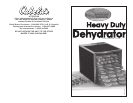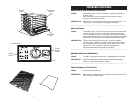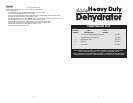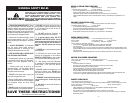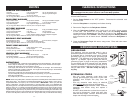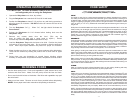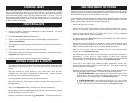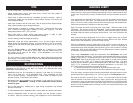
• Do not overlap foods. Lay foods flat on the Dehydrating Trays.
• Check dryness after 6 hours, then check every 2 hours until crisp, pliable or
leathery depending on the product.
• Check foods to make sure they are completely dry before removing. Open or
cut down the middle of a few samples to check internal dryness. If the food is still
moist, dehydrate longer.
• Label each container with the food name, date of drying and the original weight.
Keep a journal to help improve drying techniques.
• Proper storage is essential to maintain quality food. Package the food when
cool. Foods can be kept longer if stored in a cool, dark, dry place. The ideal
storage temperature is 60
o
F (16
o
C) or lower.
• Place dried foods in plastic freezer bags before storing in metal or glass
containers. Remove as much air as possible before sealing.
• Vacuum sealing is ideal for keeping dried foods.
• Remember, foods will shrink approximately 1/4 to 1/2 their original size and
weight during the dehydration process, so pieces should not be cut too small.
One pound of raw meat will yield approximately 1/3 lb. (0.2 kg) to 1/2 lb. (0.2 kg)
of jerky.
• Use the Drying Guide on the Control Panel as a reference for proper
temperature settings. If the heat is set too high, food may harden and dry on
the outside...yet be moist on the inside. If the temperature is too low, the
drying time will increase.
• For easy clean-up, place the Tray Liner on the bottom Tray when drying items
that may drip. Do not place items to be dried on the Tray with the Liner as there will
be no circulation of air on this Tray.
TIPS
While it is not necessary to reconstitute your dried foods, you can do so with ease.
Vegetables can be used as a side dish or in recipes very effectively after being
reconstituted in the following way.
• Dehydrated food can be re-hydrated by soaking in cold water for 3-5 minutes.
Use 1 cup of water for 1 cup of dehydrated food. Once re-hydrated, the food
can be cooked normally. Soaking foods in warm water will speed up the
process, however, it may result in loss of flavor.
• Dehydrated fruits and vegetables can be soaked in cold water for 2-6 hours in
the refrigerator. WARNING! Soaking at room temperature allows harmful
bacteria to grow.
• Do not add seasoning. Adding salt or sugar during re-hydration may change
the flavor of the food.
• To make stewed fruits or vegetables, add 2 cups of water and simmer until tender.
• Consume dehydrated foods as soon as possible once the storage container
is opened. Keep any unused portions in the refrigerator to avoid contamination.
REHYDRATING
MAKING JERKY
Your meat should be as lean as possible. Using lean meat will help the meat dry
faster and aid in cleanup by decreasing fat drippings. Ground meat should be 80%
to 90% lean. Ground turkey, venison, buffalo and elk are other excellent choices for
jerky.
Jerky seasonings are available for all tastes, or you can get creative and make your
own. Whenever you make jerky, you should treat the mixture with cure (sodium
nitrite). The cure is used to help prevent botulism during drying at low temperatures.
Follow the manufacturer’s directions on the cure packet.
Keep raw meats and their juices away from other foods. Marinate meats in the
refrigerator. Do not leave meats un-refrigerated. Prevent cross-contamination by
storing dried jerky away from raw meat. ALWAYS wash hands thoroughly with soap
and water before and after working with meat products. Use clean equipment and
utensils.
Keep meat and poultry refrigerated at 40°F (5
o
C) or slightly below; use or freeze
ground beef and poultry within 2 days; whole red meats, within 3 to 5 days. Defrost
frozen meat in the refrigerator, not on the kitchen counter.
Special considerations must be made when using venison or other wild game, as
it can become heavily contaminated during field dressing. Venison is often held at
temperatures that could potentially allow bacteria to grow, such as when it is being
transported. Refer to the USDA Meat and Poultry Department for further questions
or information on meat and food safety.
When using a Dehydrator, check the temperature of the Dehydrator with a dial
thermometer before drying jerky. The minimum recommended temperature for drying
meats is 145°F (63
o
C). Temperatures below 145°F (63
o
C) are not recommended.
IMPORTANT: Before you place the meat in a dehydrator, it is highly recommended
to heat the meat to 160°F (71
o
C) beginning the dehydrating process. This step
assures that any bacteria present will be destroyed by wet heat. After heating to
160°F (71
o
C), maintaining a constant dehydrator temperature of 130-140°F (55-
60
o
C) during the drying process is important because:
1.) the process must be fast enough to dry food before it spoils; and
2.) it must remove enough water so that microorganisms are unable to grow.
If you are using a marinade, shake off excess liquid before placing the meat in evenly
spaced single layers approximately 1/4” (0.64 cm) apart on the Dehydrator racks.
Dry meat at 145-150°F (63-66
o
C) for 4-7 hours. You may need to blot fat droplets
from the surface of the meat occasionally, using a paper towel. Drying times may
vary based on many circumstances including but not limited to: the relative humidity
of the room, the temperature of the meat at the beginning of the drying process, the
amount of meat in the dehydrator, leanness of meat, etc. Always allow jerky to cool
before taste testing.
-8- -9-



